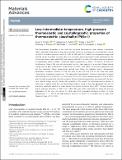Files in this item
Low-intermediate-temperature, high-pressure thermoelastic and crystallographic properties of thermoelectric clausthalite (PbSe-I)
Item metadata
| dc.contributor.author | Knight, Kevin S. | |
| dc.contributor.author | Gibbs, Alexandra S. | |
| dc.contributor.author | Bull, Craig L. | |
| dc.contributor.author | Powell, Anthony V. | |
| dc.contributor.author | Funnell, Nicholas P. | |
| dc.contributor.author | Ridley, Christopher J. | |
| dc.date.accessioned | 2022-02-01T11:30:04Z | |
| dc.date.available | 2022-02-01T11:30:04Z | |
| dc.date.issued | 2022-01-17 | |
| dc.identifier | 277679864 | |
| dc.identifier | dd922349-6ee8-4d00-9bfa-a7ae82dc3229 | |
| dc.identifier | 000744596200001 | |
| dc.identifier | 85125575794 | |
| dc.identifier.citation | Knight , K S , Gibbs , A S , Bull , C L , Powell , A V , Funnell , N P & Ridley , C J 2022 , ' Low-intermediate-temperature, high-pressure thermoelastic and crystallographic properties of thermoelectric clausthalite (PbSe-I) ' , Materials Advances , vol. Advance Article , pp. 2077-2088 . https://doi.org/10.1039/D1MA01093J | en |
| dc.identifier.issn | 2633-5409 | |
| dc.identifier.other | RIS: urn:B1F814F328C60244D933D2663305D44F | |
| dc.identifier.other | ORCID: /0000-0002-7012-1831/work/107718160 | |
| dc.identifier.uri | https://hdl.handle.net/10023/24785 | |
| dc.description.abstract | The thermoelastic properties of the rock-salt structured thermoelectric lead selenide (clausthalite, PbSe-I) have been determined using neutron powder diffraction techniques for the temperature interval 10–500 K at ambient pressure, and 0–5.2 GPa at 298, and 150 K. Within this temperature range, lead selenide can be described using the same self-consistent phenomenological model developed for the isostructural phases lead sulfide (PbS) and lead telluride (PbTe) in which the cations and anions behave as independent Debye oscillators (vibrational Debye temperatures of PbSe-I: Pb 111(1) K, Se 205(1) K). Simultaneous fitting of the unit cell volume and isochoric heat capacity to a two-term Debye internal energy function gives characteristic temperatures of 104(3) K and 219(5) K in excellent agreement with the two vibrational Debye temperatures derived from fitting the individual atomic displacement parameters. Grüneisen constants for the two term fits are 1.79 and 2.28 for the lower and upper characteristic temperature respectively. The calculated thermodynamic Grüneisen parameter increases monotonically from 2.03 at 10 K, to a maximum 2.22 at 100 K before decreasing back to 2.00 at 298 K and is broadly in agreement with the average of the two Grüneisen parameters associated with the two-term internal energy function. Despite the simplicity of the model, the calculated phonon density of states that is implicit within the two-term Debye model is found to show fair agreement with the full and partial vibrational densities of states derived from density functional theory (DFT). The bulk modulus and its pressure derivative at 298 K are 47.9(4) GPa and 5.4(2) respectively by fitting the pressure dependence of the unit cell volume to a 3rd order Birch-Murnaghan equation-of-state. For lower temperatures (T < 300 K) the high-pressure transition to PbSe-II is associated with a steep initial Clapeyron slope of 151 K GPa−1. | |
| dc.format.extent | 12 | |
| dc.format.extent | 2967529 | |
| dc.language.iso | eng | |
| dc.relation.ispartof | Materials Advances | en |
| dc.subject | QD Chemistry | en |
| dc.subject | NDAS | en |
| dc.subject.lcc | QD | en |
| dc.title | Low-intermediate-temperature, high-pressure thermoelastic and crystallographic properties of thermoelectric clausthalite (PbSe-I) | en |
| dc.type | Journal article | en |
| dc.contributor.institution | University of St Andrews. School of Chemistry | en |
| dc.contributor.institution | University of St Andrews. Centre for Designer Quantum Materials | en |
| dc.identifier.doi | https://doi.org/10.1039/D1MA01093J | |
| dc.description.status | Peer reviewed | en |
This item appears in the following Collection(s)
Items in the St Andrews Research Repository are protected by copyright, with all rights reserved, unless otherwise indicated.

